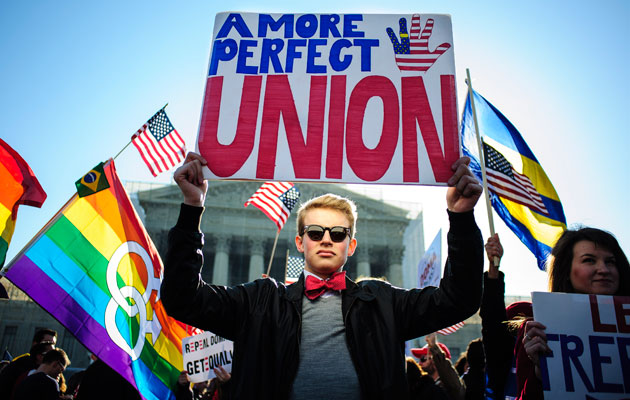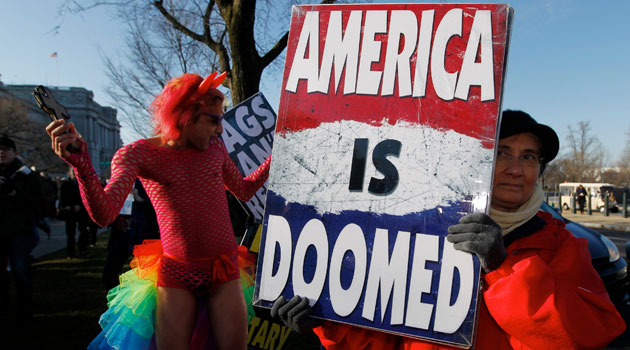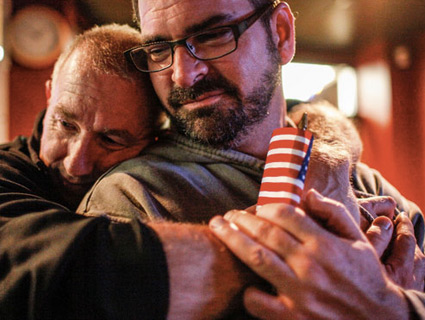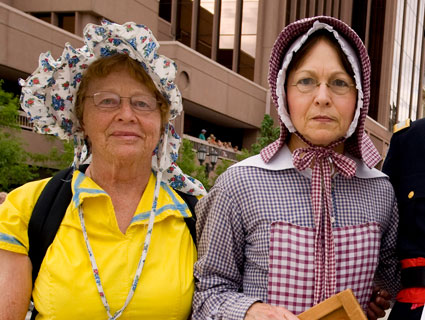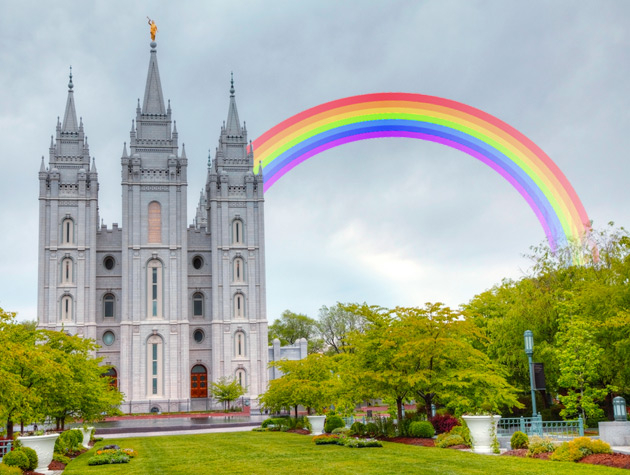
Photoillustration by <a href="http://www.motherjones.com/authors/dave-gilson">Dave Gilson</a>/MoJo. Shutterstock photos by <a href="http://www.shutterstock.com/pic-109669508/stock-photo-mormons-temple-in-salt-lake-city-ut-in-the-evening.html">photo.ua</a> (temple) and <a href="http://www.shutterstock.com/pic-108300971/stock-vector-vector-icon-rainbow.html?src=Z16kczFGwQWk_Ip1SoqJWg-1-3">zzveillust</a> (rainbow)
Last month, hundreds of boisterous protesters converged in Washington, DC, as the Supreme Court heard oral arguments in Hollingsworth v. Perry, the lawsuit challenging the constitutionality of California’s anti-gay marriage initiative, Proposition 8. Faith-based groups were on prominent display: the Methodists supporting marriage equality, the Westboro Baptists suggesting (per usual) that “God hates fags,” the Catholics both for and against gay marriage, clergy of all stripes. But one group that wasn’t there in any official capacity was the Church of Jesus Christ of Latter-day Saints—a.k.a. the Mormons—which perhaps more than any other religious group was responsible for getting Prop. 8 passed in the first place.
In the five years since the LDS church sent busloads of the faithful to California to canvass neighborhoods, and contributed more than $20 million via its members to support the initiative, it has all but dropped the rope in the public policy tug of war over marriage equality. The change stems from an even more remarkable if somewhat invisible transformation happening within the church, prompted by the ugly fight over Prop. 8 and the ensuing backlash from the flock.
Although the LDS’s prophet hasn’t described a holy revelation directing a revision in church doctrine on same-sex marriage or gay rights in general, the church has shown a rare capacity for introspection and humane cultural change unusual for a large conservative religious organization.
“It seems like the [Mormon] hierarchy has pulled the plug and is no longer taking the lead in the fight to stop same-sex marriage,” says Fred Karger, the LGBT activist who first exposed the church’s major role in the passage of Prop. 8. “The Mormon Church has lost so many members and suffered such a black eye because of all its anti-gay activities that they really had no choice. I am hopeful that the Catholic Church cannot be far behind.”
The LDS church has been a driving force against gay-marriage initiatives since at least 1995. It was instrumental in fending off same-sex marriage in Hawaii and Alaska and, in 2000, it helped pass California’s Proposition 22 (the Prop. 8 precursor known as the Knight Initiative), which defined marriage as solely between a man and woman. (Prop. 22 was struck down by the California Supreme Court in 2008.)
The church’s anti-gay positions and lobbying on gay marriage have always been divisive. In 2000, during the fight over the Knight Initiative, a young gay Mormon named Stuart Matis killed himself on the steps of a Mormon ward in Los Altos, California. In a letter to his cousin shortly before his suicide, he despaired over the impact of the church’s political activities on Mormon families: “On the night of March 7th, many California couples will retire to their beds thrilled that they helped pass the Knight Initiative. What they don’t realize is that in the next room, their son or daughter is lying in bed crying and could very well one day be the victim of society’s homophobia. The Knight Initiative will certainly save no family. It is codified hatred. It is anti-family, anti-love and it is wrong.”
But Matis’ death didn’t slow the church’s efforts to beat back same-sex marriage initiatives. In 2008, after the California Supreme Court briefly legalized gay marriage in the state, the Latter Day Saints lent their formidable organizing skills and networks to the Prop. 8 effort, sending canvassers door to door by zip code—sometimes as many as 25,000 per weekend—much as they send out missionaries to spread the Gospel. The church has been credited with almost single-handedly getting Prop. 8 passed, despite a well-funded opposition with backing from Hollywood.
Prop. 8 was a Pyrrhic victory for the Mormons, however. Their role, which the church sought to keep under wraps, was exposed by Karger, who tracked the individual donations pouring into the Yes on 8 campaign back to church members. LGBT activists responded by publicizing the church’s involvement, running an ad, for example, showing fake Mormon missionaries knocking on the door of a lesbian couple and then rifling through their drawers and tearing up their marriage license.
The negative exposure prompted protests, and many Mormons publicly renounced their church membership. One of them was then 28-year-old Matthew Lawrence, the son of official LDS pollster Gary Lawrence, who had led the Prop. 8 fight. “I love my family so much, but it’s hard to not take this personally. We had a brief falling-out over Prop. 22, but that got mended. But two anti-gay initiatives in eight years, it’s impossible not to feel attacked,” Matthew, who is gay, wrote in 2008.
The LDS church had always struggled for public acceptance, and the negative press wasn’t helping. One poll, conducted a year after Prop. 8 passed, showed that the church’s favorability rating had fallen from 42 percent to 37 percent. But its image problem was nothing compared to the internal rifts the Mormons were experiencing. “The church probably deserved the black eye we got from Prop. 8,” says Mitch Mayne, an openly gay Mormon leader in the San Francisco area. “What the non-Mormon world didn’t get to see was how destructive that was inside the faith.”
In response to the anger within Mormon ranks over Prop. 8, the president of the Oakland, California, stake (a stake is akin to a Catholic diocese) began organizing gatherings of gay and straight members to try to bridge the differences. In September 2010, the disgruntled church members received a private audience with one of the church’s top officials, Marlin Jensen, who serves as the LDS’s historian. The church members tearfully told Jensen their stories—of being shunned by their families, and the homophobia generated by the Prop. 8 campaign. “We explained that [the church had] pitted father against son, mother against daughter, exactly the opposite of what we stand for,” says Mayne, who attended the meeting.
After listening to them talk, Jensen did something almost unheard of in a church whose strict authoritarian hierarchy is unaccustomed to being challenged from below: He apologized “for the pain that Prop. 8 caused [us],” Mayne recalls, choking up at the memory. It was, he says, a “very meaningful event.”
The apology from a high church official turned out to be just the beginning of a cultural shift toward greater acceptance of gays and lesbians within LDS ranks. In 2011, Mayne was called to serve as an official of his local San Francisco ward, as an openly gay man. It was a historic appointment in an institution with a long history of excommunicating openly gay members, which it referred to as people who were “afflicted” with same-sex attraction.
Since then, the church has opened its doors to LGBT members in many places, Mayne says: “Everybody is welcome here. Nobody is under that threat of being excommunicated.” In 2012, the church even created a website, Mormonsandgays.org, to convey its desire for more-humane treatment of LGBT members. Also last year, about 300 straight Mormons marched in the Salt Lake City pride parade, a significant and emotional first. Mayne says the new website, like the church, still has a long way to go, but he and other gay Mormons see it as a step in the right direction.
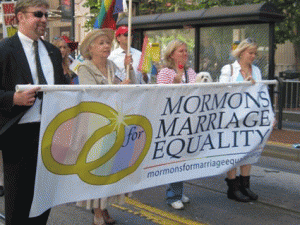
Perhaps most significantly, the church has made a concerted effort to bring LGBT kids back into the fold. Mayne points out that gay Mormon kids have significantly higher suicide rates than gay non-Mormon ones—a problem that has been attributed to the church’s longtime policy of forcing parents of gay kids to choose between their church and their children. It also has long been common practice for Mormon parents to kick LGBT adolescents out of their homes because of their sexual orientation. (When Matt Lawrence, the church pollster’s son, broke with his family over Prop. 8, he told stories about his family’s efforts to “straighten me out” by sending him to live with homophobic cousins in Utah.) Utah foster parents, too, generally won’t take in LGBT children. That’s one reason why heavily Mormon Utah has so many homeless LGBT kids on the streets. But even that is starting to change.
The church has worked with the Family Acceptance Project at San Francisco State University to craft an educational booklet aimed specifically at helping Mormons parent their gay kids, to keep them safe at home and to prevent suicide. It’s a remarkably humane document instructing church members on how to embrace their gay kids even when they’re uncomfortable with their purple hair and transgendered friends. The pamphlet is now being used in lots of Mormon wards. Meanwhile, in Salt Lake City, where the church is headquartered, the church has teamed up with the LGBT community to open a shelter for young homeless people there, about 40 percent of whom are known to be LGBT.
“The LGBT community had reached out to the church several times before Prop. 8 and we’ve never been able to connect,” says Jim Dabakis, head of the Utah Democratic Party and cofounder of the Utah Pride Center in Salt Lake, who has been involved in these conversations. But after the Prop. 8 backlash, the Utah LGBT community, along with national leaders, commenced a series of meetings with church hierarchy. The first meetings were “a bit uncomfortable,” Dabakis recalls. But then, “as we began to meet, and we began to introduce our families, it became much less an issue about legal points, what is the definition of a family, what kind of overarching legal principals are involved, and much more about Christian values and how people should be treated. Minds changed on both sides.”
Not everything has changed, of course. The church still filed an amicus brief with the Supreme Court in support of Prop. 8, although it doesn’t read like the same sort of full-throated anti-gay sentiment that drove the initiative. The church lawyers who drafted the document seem to have bent over backward to express how much they like gays, and to frame the issue in terms of states’ rights, as opposed to morality.
Mormon church doctrine still defines homosexuality as a sin. The gay Mormon website clarifies that while having a same-sex attraction is not a sin, acting on it is. Mayne was only able to take on his leadership role in the church after he broke up with his longtime partner and was single again. And noncelibate LGBT members are still excluded from “temple recommends”—access to the church’s most sacred spaces and ceremonies.
Dabakis says that there are still many points of disagreement. “I don’t think the church has given one iota on gay marriage—maybe they never will—and neither have we. On the other hand, we have found a lot of commonalities that we can work on,” he says, pointing towards the joint efforts to help homeless kids.
The LGBT community’s best evidence of change within the church is that last year, in the only four states ever to pass marriage equality laws, the church “did not provide one dime or one volunteer,” Dabakis says. He adds that in Maryland, when one local Mormon leader tried to organize to oppose a pro-marriage-equality initiative, the church shut her down.
Regardless of how the Supreme Court rules in the Prop. 8 case, the church responsible for its passage has been permanently changed for the better. In Mayne’s view, this all means that Prop. 8, with all its ugliness, happened for a reason: “I believe in our attempt to nail shut the Pandora’s box of gay marriage, we essentially blew the lid off of it.”

